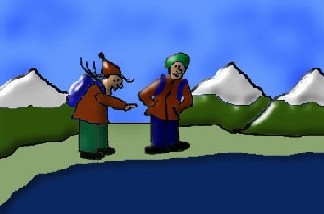What do you think they will find in the lake?
Click on image for full size
Windows to the Universe original image
The Search for Life on…Earth!
News story originally written on November 3, 2002
By studying what lives in the highest lakes on Earth, scientists hope to learn how life may survive in other harsh environments throughout the solar system.
One of the lakes that will be studied is a caldera that sits atop Licancabur volcano in the Andes Mountains of Chile. A caldera is the name for a lake that forms in the collapsed top of a volcano. The harsh environmental conditions at this caldera make it one of the most Mars-like places on Earth.
The environment is tough to survive in because at high altitudes pressure is lower so there are less oxygen molecules in each breath of air, more ultraviolet (UV) sunlight, and it is very cold.
Even though the lakes are in harsh environmental conditions, certain tiny life forms can survive and the scientist team hopes to learn how they do this. “Only by going there will we find out,” says Dr. Nathalie Cabrol, the principle investigator of the project, whose team will identify and describe the organisms that they find in the lake during the 25-day mission to the Andes Mountains which began on October 16, 2002. If the scientists know how these life forms survive harsh conditions on Earth, they can understand the ways that life may have adapted to exist on Mars, or Jupiter’s moon Europa, today or in the past.
Last modified October 23, 2002 by Lisa Gardiner.
You might also be interested in:

Europa was first discovered by Galileo in 1610, making it one of the Galilean Satellites. It is Jupiter's 4th largest moon, 670,900 km from Jupiter. With a diameter that is about half the distance across
...more
It was another exciting and frustrating year for the space science program. It seemed that every step forward led to one backwards. Either way, NASA led the way to a great century of discovery. Unfortunately,
...more
The Space Shuttle Discovery lifted off from Kennedy Space Center on October 29th at 2:19 p.m. EST. The weather was great as Discovery took 8 1/2 minutes to reach orbit. This was the United States' 123rd
...more
A moon was discovered orbiting the asteroid, Eugenia. This is only the second time in history that a satellite has been seen circling an asteroid. A special mirror allowed scientists to find the moon
...more
Will Russia ever put the service module for the International Space Station in space? NASA officials want an answer from the Russian government. The necessary service module is currently waiting to be
...more
A coronal mass ejection (CME) happened on the Sun early last month. The material that was thrown out from this explosion passed the ACE spacecraft. The SWICS instrument on ACE has produced a new and very
...more
J.S. Maini of the Canadian Forest Service called forests the "heart and lungs of the world." This is because forests filter air and water pollution, absorb carbon dioxide, release oxygen, and maintain
...more















